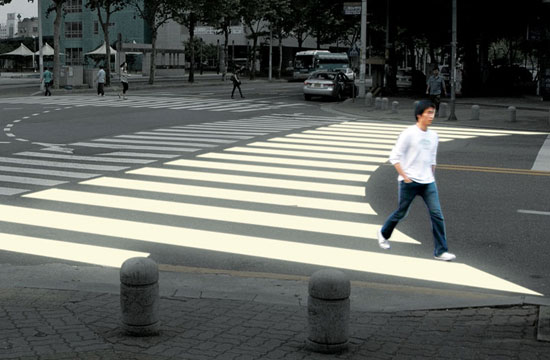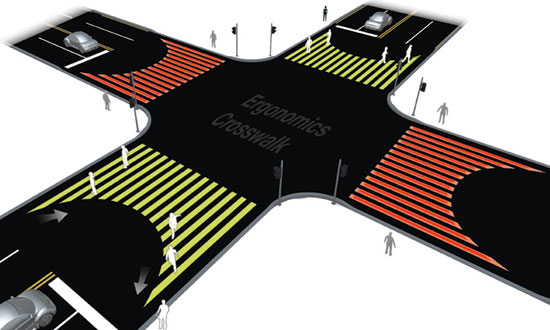Traffic calming can take a number of different forms, from speed tables to roundabouts, but CNN recently ran a story about an unconventional new traffic calming pilot in Vancouver, Canada, that has people literally doing double takes.
Traffic managers there painted a three dimensional image onto the street that appears to drivers to resemble a child playing with a ball. The CNN anchor was highly skeptical of the visual device, arguing it was likely to cause more car crashes than it would help avert. The show's viewers, who seem to approach the concept from the viewpoint of drivers, tended to agree.
While this experiment uses quite sophisticated visual cues, it's arguably in the same traffic calming genus as the intersection painting and neighborhood design projects Streetfilms has documented in Portland, Oregon. These mental speed bumps, to borrow David Engwich's phrase, present an unexpected, living streetscape to drivers that disrupts the expected conditions and compels a reduction in speed. Like woonerfs, or shared streets where traffic control devices are eliminated, the concept at first seems counter-intuitive and dangerous, but the positive effect can be welcome to pedestrians. Traffic data from cities with shared streets show a remarkable decline in collisions, primarily because the streets have been designed for slow speeds and pedestrian primacy.

Meanwhile, a new "Ergonomic Crosswalk" presented to the Seoul International Design Competition could improve pedestrian safety, or at least codify the trajectory pedestrians take when crossing a street. As anyone who has spent time in compact cities knows, the straight lines of the crosswalk rarely reflect the path that you takes to cross the street. People often step off the sidewalk before walking to the very edge of the crosswalk and step onto the opposite sidewalk along an arc that gets you to your destination quicker.
These new designs begin to reflect a new consideration in street design, where cars are not the primary consideration, but people and public spaces are valued as much as movement of vehicles. It reminds us of Peter Norton's primer on the history jaywalking, where he noted that even the term "jay walking" reflects the dominance of automobiles in society. Before the rise of cars in transportation and the re-shaping of cities to accommodate their movement, people and horses and bicycles all shared the street, much like a woonerf. Walkers weren't trespassing in streets belonging to automobile traffic, but the other way around.
As the artist, Jae Min Lim, noted with the design presentation, "When people cross roads, they tend to take the fastest shortcut. They sometimes do it intentionally, but mostly it is an unconscious act. This kind of action violates the traffic regulations and sometimes threatens the safety of the pedestrians.... If regulations cannot force people to follow the law, wouldn't it be more reasonable to change the law and fulfill the main purpose of keeping the safety and convenience of the pedestrian?"
Before critics cry too loudly, this is essentially how speed limit laws on streets have been set. In California, as with many other states, speed limits on streets are routinely set to the 85th percentile rule, or the speed at which which 85 percent of traffic travels (see TRB link here).
Presumably in cities where a balance of modalities is restored and pedestrians are given due consideration, design cues like paintings in streets and crosswalks that reflect pedestrian desire lines will become standard.

h/t Design Boom





